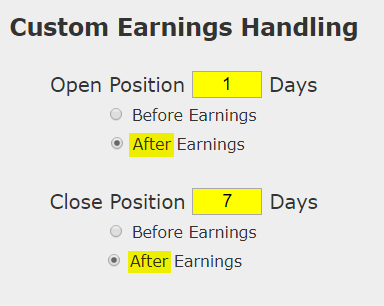The Volatility Option Trade After Earnings in Intel Corporation

Intel Corporation (NASDAQ:INTC) : The Volatility Option Trade After Earnings
Date Published: 2018-07-27
Disclaimer
The results here are provided for general informational purposes, as a convenience to the readers. The materials are not a substitute for obtaining professional advice from a qualified person, firm or corporation.LEDE
This is a slightly advanced option trade that checks for volatility for a period that starts one-day after Intel Corporation (NASDAQ:INTC) earnings and lasts for the 6 calendar days to follow, that has been a winner for the last 2 years.We just saw an identical strategy work with PayPal after earnings two-days ago. Now, Intel just released earnings on 7-26-2018, and Wall Street has not liked the report, taking the stock down sharply. One day after 7-26-2018 would be 7-27-2018, near the close of trading.
Intel Corporation (NASDAQ:INTC) Earnings
In Intel Corporation, if we waited one-day after earnings and then bought an one-week out-of-the-money (40 delta) strangle (using two-week options), the results were quite strong. This trade opens one-day after earnings were announced to try to find a stock that moves a lot after the earnings announcement.Simply owning options after earnings, blindly, is likely not a good trade, but hand-picking the times and the stocks to do it in can be useful. We can test this approach without bias with a custom option back-test. Here is the timing set-up around earnings:

Rules
* Open the long out-of-the-money strangle (40 delta) one-calendar day after earnings.* Close the strangle 7 calendar days after earnings.
* Use the options closest to 14 days from expiration (but more than 7 days).
This is a straight down the middle volatility bet -- this trade wins if the stock is volatile the week following earnings and it will stand to lose if the stock is not volatile. This is not a silver bullet -- it's a trade that needs to be carefully examined.
But, this is a stock direction neutral strategy, which is to say, it wins if the stock moves up or down -- it just has to move.
RISK CONTROL
Since blindly owning volatility can be a quick way to lose in the option market, we will apply a tight risk control to this analysis as well. We will add a 40% stop loss and a 40% limit gain.
In English, at the close of every trading day, if the strangle is up 40% from the price at the start of the trade, it gets sold for a profit. If it is down 40%, it gets sold for a loss. This also has the benefit of taking profits if there is volatility early in the week rather than waiting to close 7-days later.
Another risk reducing move we made was to use 14-day options and only hold them for 7-days so the trade doesn't suffer from total premium decay.
RESULTS
If we bought the out-of-the-money strangle in Intel Corporation (NASDAQ:INTC) over the last two-years but only held it after earnings we get these results:| INTC Long Out-of-the-Money Strangle |
|||
| % Wins: | 71% | ||
| Wins: 5 | Losses: 2 | ||
| % Return: | 215% | ||
Tap Here to See the Back-test
The mechanics of the TradeMachine® Stock Option Backtester are that it uses end of day prices for every back-test entry and exit (every trigger).
Track this trade idea. Get alerted for ticker `INTC` 1 days after earnings
Looking at Averages
The overall return was 215%; but the trade statistics tell us more with average trade results:➡ The average return per trade was 45.2% over 6-days.
➡ The average return per winning trade was 75.2% over 6-days.
➡ The average return per losing trade was -30% over 6-days.
Looking at the Last Year
While we just looked at a multi-year back-test, we can also hone in on the most recent year with the same test:Now we see a 75.8% return over the last year and a 75% win-rate.
➡ The average return for the last year per trade was 41.8% over 6-days.
➡ The average return for the last year per winning trade was 66.4% over 6-days.
➡ The average return per losing trade was -31.7% over 6-days.
WHAT HAPPENED
This is how people profit from the option market. Take a reasonable idea or hypothesis, use a rationale system to help overcome cognitive biases, and test it. Tap the link below to learn more:Tap Here to See the Tools at Work
Risk Disclosure
You should read the Characteristics and Risks of Standardized Options.
Past performance is not an indication of future results.
Trading futures and options involves the risk of loss. Please consider carefully whether futures or options are appropriate to your financial situation. Only risk capital should be used when trading futures or options. Investors could lose more than their initial investment.
Past results are not necessarily indicative of future results. The risk of loss in trading can be substantial, carefully consider the inherent risks of such an investment in light of your financial condition.
Please note that the executions and other statistics in this article are hypothetical, and do not reflect the impact, if any, of certain market factors such as liquidity and slippage.


